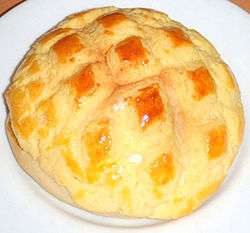Pineapple bun
 | |
| Alternative names | Bo lo baau |
|---|---|
| Type | Sweet bun |
| Place of origin | Hong Kong |
| Main ingredients | Sugar, eggs, flour, and lard |
|
| |
| Pineapple bun | |||||||||||||||
|
| |||||||||||||||
| Traditional Chinese | 菠蘿 包 | ||||||||||||||
|---|---|---|---|---|---|---|---|---|---|---|---|---|---|---|---|
| Simplified Chinese | 菠萝 包 | ||||||||||||||
| Literal meaning | pineapple bun | ||||||||||||||
| |||||||||||||||
A pineapple bun is a kind of sweet bun predominantly popular in Hong Kong and Macau,[1] though they are also common in Chinatowns worldwide.[2] It is known in Cantonese as bo lo baau, in which bo lo means "pineapple", and baau refers to a kind of bun-like item in Chinese cuisine.[3]
History
In June 2014, the Hong Kong Government listed the pineapple bun as a part of Hong Kong's intangible cultural heritage. Tai Tung Bakery in Yuen Long, which had been making pineapple buns for more than 70 years, was a key proponent of including the technique for making the buns on the list of 480 items of living heritage.[4]
In September 2014, a police raid found that several suppliers (including Starbucks, 7-Eleven and Cafe Express) had been selling pineapple buns made with tainted oil, known as "gutter oil", from an unlicensed factory in Taiwan. This oil was recycled from kitchen waste, as well as being a by-product of leather processing and offal from slaughterhouses.[5]
Composition
The top of the pineapple bun (the part which is made to resemble a pineapple) is made of a dough similar to that used to make sugar cookies, which consists of sugar, eggs, flour, and lard. It is crunchy and is quite sweet compared to the bread underneath. The bread dough underneath is the same used in Chinese style Western breads, which is a softer and sweeter dough compared to Western breads. It is popular with breakfast or afternoon tea.
Although it is known as "pineapple bun", the traditional version contains no pineapple. The name originated from the fact that its sugary top crust is cooked to a golden-brown color, and because its checkered top resembles the epicarp of a pineapple.[6]
Buttered variant
Many Hong Kong restaurants, such as cha chaan tengs and dai pai dongs, offer an item called a buttered pineapple bun, which is a pineapple bun with a piece of butter stuffed inside. They are known in Cantonese as bo lo yau (菠蘿油), in which bo lo means "pineapple", and yau (oil) refers to butter. Variants of this include using custard in place of butter.
Typically, the bun would be brought hot from the oven to the diner's table, and served halved with a large slab of butter in between the halves. This item is sometimes criticised for containing too much fat and cholesterol.
Other common variants
The pineapple bun may come in miniature sizes (迷你菠蘿包), it may be used as a bread roll for sandwiches with luncheon meat (餐肉菠蘿包), or it may be pre-stuffed with red bean paste (紅豆菠蘿包), custard cream (奶黃菠蘿包), barbecued pork (叉燒菠蘿包), or a sweet filling of shredded coconut (椰絲菠蘿包) like that in a cocktail bun. It is possible to order a "pineapple pineapple bun", actually stuffed with pineapple (菠蘿菠蘿包), although this is very likely the product of misinterpretation of the name by non-native bakers.
Japanese melonpan and Korean soboro bread[7] are variants that use the same ingredients for a German streusel-like texture on top but without resemblance to a pineapple.
In popular culture
- McDull, the main character in the Hong Kong cartoon film McDull, Prince de la Bun is often seen with a pineapple bun, since the Chinese name of the film is 菠蘿油王子 (Prince of Pineapple Bun with Butter).[8]
- In 2005, "pineapple bun" was nominated as the name of a typhoon, but was rejected because the director of the Hong Kong Observatory stated that news reports concerning the typhoon would sound nonsensical.[9]
See also
- Baozi
- Bun
- List of buns
- Melonpan, the Japanese equivalent of pineapple bun
References
- ↑ "Hong Kong food: 40 dishes we can't live without - 6. 'Pineapple' bun". CNN Travel. 13 July 2010. Retrieved 5 January 2014.
- ↑ "What Is a Pineapple Bun". wisegeek. Conjecture Corporation. Retrieved 5 January 2014.
- ↑ So, Winnie (27 May 2012). "Hong Kong's best bun". CNN Go. Retrieved 2 June 2012.
- ↑ Tsang, Denise (8 September 2014). "The secrets behind serving up Hong Kong's 'hot cross buns'" (8 September 2014). South China Morning Post. Retrieved 23 November 2014.
- ↑ Starbucks and 7-Eleven in Hong Kong drawn into ‘gutter oil’ scandal | South China Morning Post
- ↑ "Where's The Pineapple?". My Kitchen: My Laboratory. Retrieved 29 June 2009.
- ↑ "Korean Soboro Bread". Korean Slate. 28 October 2009. Retrieved 24 August 2011.
- ↑ "麥兜菠蘿油王子 Mcdull, Prince de la Bun (Chinese)". Sina Hong Kong. Retrieved 14 January 2014.
- ↑ "Ask Mr. Know-It-All: How do typhoons get their names?". hk-magazine.com. HK Magazine. Retrieved 11 February 2015.
External links
| Wikimedia Commons has media related to Pineapple bun. |